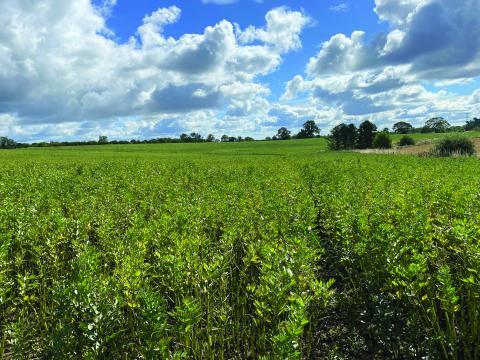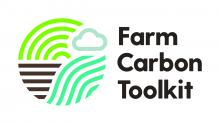What we did[1]
The Farm Carbon Toolkit carried out an emissions modelling exercise based on a constructed baseline, which is considered realistic within a UK context. The baseline consisted of a 100 ha arable enterprise, following a conventional rotation and agronomic input, growing milling wheat, feed wheat and oilseed rape. Assumptions on inputs used were based on John Nix pocketbook, RB209 and input from agronomy experts.
The Farm Carbon Calculator (FCC) was used to calculate the likely emissions from the baseline model including inputs, land area and field operations carried out on contract. A range of regenerative scenarios were then applied to this baseline, to assess their impact on greenhouse gas emissions from the 100 Ha farmed area. The potential for carbon sequestration was not modelled as part of the exercise at this stage.
What we found out
The baseline model shows that the emissions associated with the arable rotation were 2.04 tCO2e/Ha/year and 0.352 tCO2e per tonne of crop per year. Figure 1 overleaf shows the breakdown of the emissions by category. From this, the dominant emission category arises from the application of fertilisers.
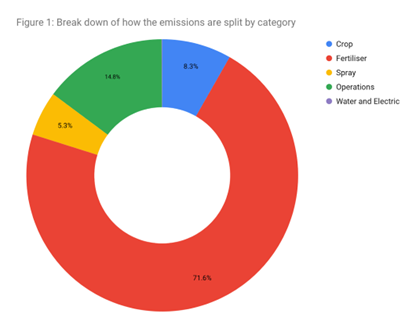
Of the emissions from fertilisers the vast majority, 96.4%, arises from the application of Ammonium Nitrate or Nitrogen fertilisers. Several adjustments to conventional growing practices were modelled by FCT, primarily focused on practices and combinations of practices which would result in reductions in greenhouse gas emissions. A total of seven options were modelled.
Options explored:
B -Baseline
- BRN -Reduced N application to all crops of 30 kg/Ha
- BRN+ -Extreme N reduction to cereal crops of 75 kg/Ha & 30 kg to OSR.
- FYr.NCC -5 year rotation including beans with N fixing cover crop
- FYr.NCC.MT -5 year rotation including beans with N fixing cover crop + min til.
- FYr.NCC -5 year rotation including beans with non N fixing cover crop.
- FYr.CC.MT -5 year rotation including beans with non N fixing cover crop + min til
- B.LF-RN+ -Baseline with Liquid N fertiliser with halved scope 1 emissions factors and extreme N fertiliser reduction as in 2) above .
The outcomes of the emissions modelling exercise per year are set out overleaf:
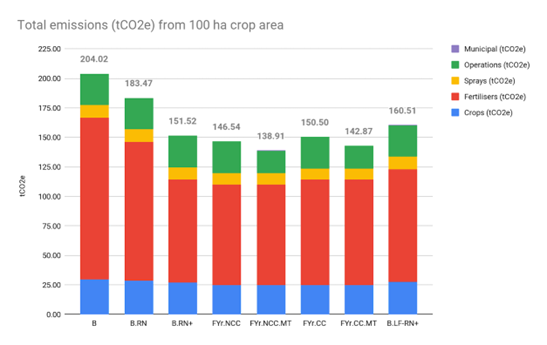
The outcomes when looked at in terms of tCO2e emissions per ton of crop/year are shown below.
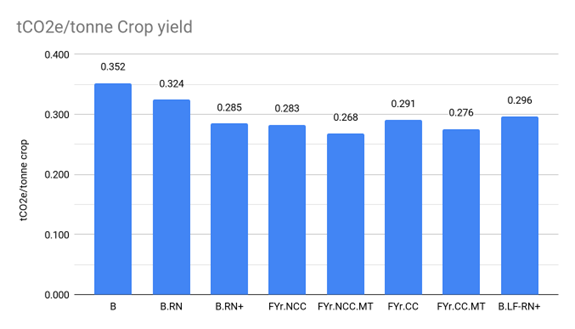
Application at scale
In the UK, legumes currently represent 5.3% of the UK’s cropping area (233,000 ha). If UK beans and pulses were increased from 5.3% cropping area to 20% (877,200 ha) i.e. one year in five as set out in the options shown above there could be a reduction of around 1,855,296t CO2e across the whole UK arable area (4.386 million has) which is equivalent to close to 4% of the total emissions from UK agriculture[1]. Within this calculation it is assumed that all arable rotations are in line with the baseline scenario before adopting beans into the rotation. This is unlikely to be the case, so this reduction in emissions needs to be looked at within this context.
Conclusion
The modelled results indicate that the adoption of regenerative growing practices can deliver reductions in anticipated greenhouse gas emissions and the greatest reduction of greenhouse gas emissions per ton of crop yield comes from a combination of including beans in rotation and pursuing regenerative cover cropping and tillage practices.
The introduction of a modelled five-year rotation including bean and an N fixing cover crop using min till cultivations reduces the overall GHG emissions by 33% compared to the baseline and results in a projected reduction of 24% GHG emissions per ton of crop. The inclusion of beans and perhaps other legumes in the rotation can aid the reduction and reliance on N fertiliser and has a likely consequential reduction in greenhouse gas emissions, but there is an anticipated negative impact on overall crop yields.
Alongside the anticipated reduction in the financial and environmental cost of crop production through reduced input costs, we [i]anticipate an increase in carbon sequestration due to improved soil health. However, changes in soil organic carbon have not formed part of the modelling exercise as the impact on soil health would depend on farm specific conditions such as soil type, management practices and weather. Nevertheless, this demonstrates the potential for even greater carbon reductions, with carbon sequestration augmenting the environmental benefit alongside the input emissions avoidance.
[1] Agriclimate Report 2023 - Defra
[i] A full set of the assumptions made are available from FCT
[1] Acknowledgement: with support from Finance Earth and the Soil Association


